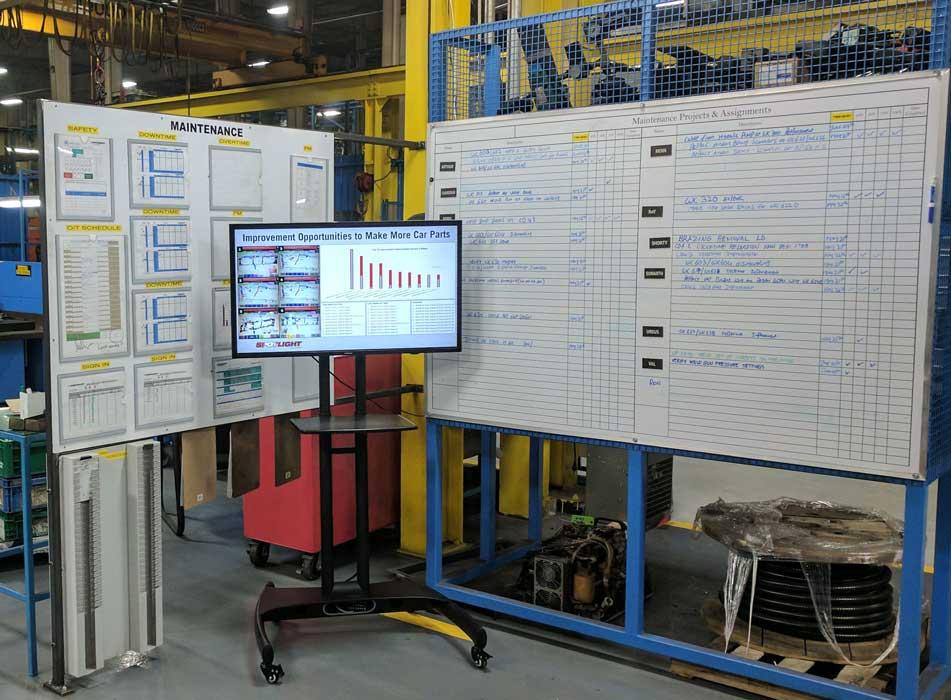Senior Editor
- FMA
- The Fabricator
- FABTECH
- Canadian Metalworking
Categories
- Additive Manufacturing
- Aluminum Welding
- Arc Welding
- Assembly and Joining
- Automation and Robotics
- Bending and Forming
- Consumables
- Cutting and Weld Prep
- Electric Vehicles
- En Español
- Finishing
- Hydroforming
- Laser Cutting
- Laser Welding
- Machining
- Manufacturing Software
- Materials Handling
- Metals/Materials
- Oxyfuel Cutting
- Plasma Cutting
- Power Tools
- Punching and Other Holemaking
- Roll Forming
- Safety
- Sawing
- Shearing
- Shop Management
- Testing and Measuring
- Tube and Pipe Fabrication
- Tube and Pipe Production
- Waterjet Cutting
Industry Directory
Webcasts
Podcasts
FAB 40
Advertise
Subscribe
Account Login
Search
Technology Spotlight: Uncovering the “why” in equipment effectiveness
Analytics tool helps uncover hidden inefficiencies
- By Tim Heston
- August 17, 2017
- Article
- Automation and Robotics
Tracking uptime and unplanned downtime is the cornerstone of any overall equipment effectiveness program and an important tenet of continuous improvement in general. But those uptime measurements really become useful only when put into context. The mere fact that a welding robot has unplanned downtime is helpful, but it’s just the tip of the iceberg.
What is really helpful to know are the causes of that unplanned downtime and how production levels relate to baseline data. That is, how many parts per hour should this workcell produce; and if it isn’t producing that amount, why not? What are the root causes?
This was the thinking behind a collaboration between two companies in Ontario, Canada: Route1, a company specializing in secure user authentication and data protection technologies, and an industrial sensors company called HTM Sensors. Their product, Spotlight, Powered by MobiNET, is designed to provide information that technicians can act upon. HTM has the sensor expertise, while Route1 has the analytic software. On-site, a data-collection device communicates with a plant’s programmable logic controllers (PLCs) to extract the data, and securely transmits it to a cloud-based analytics platform. The results are consolidated on dashboards that are viewed on large displays at the plant as well as on a secure web-based portal.
“We can automate the analytics so that results can be delivered in real time,” said Brian Brunetti, president of Route1. “This goal led to this joint initiative.”
“And all this has to happen securely, because of course we’re dealing with proprietary information,” said Bob Hooper, president of HTM Sensors.
Factories install sensors to track what’s really going on in an automated cell. Often, though, these sensors flood the operation with data. Gathering data is great, but if people can’t act on it, it’s useless.
“It comes down to the manufacturer never really knowing where they’re having unplanned downtime,” Hooper said. “It could be an unplanned welding tip change, a broken cable, or a variety of reasons. We wanted to dig down to the input level. Out of the thousands of inputs in a typical welding plant, could we pinpoint the ones that cause the most downtime?”
Sensors send data to the PLC. “And the system knows what a good cycle looks like,” Hooper explained. “The software is able to determine this both in terms of time and the operations that need to occur. And then it’s able to identify the cycles that have a problem.
“It’s also taking information right from the machine,” Hooper continued, adding that it’s not reliant on operator input. It’s also control-agnostic; according to sources, whatever the PLC brand, the Spotlight system can work with it. “It doesn’t matter which technology is being used, so long as we can collect data through the PLC.”
The system provides a “top 10 list,” showing the top inputs that tend to cause downtime. “People need actionable data,” said Hooper. “So the system uncovers the top inputs that are causing the most problems. In a typical weld cell line with, say, six welding robots, you could have more than 400 sensors. In all of this, we want to show 10 exact inputs that cause the most downtime, in the form of the number of instances and the aggregate amount of time.”
“This is based on the real-time analytics that’s ongoing,” said Tony Busseri, Route1 CEO. “And this list is updated in real time, so that list may change from minute to minute or hour to hour.”
“We get very granular,” Hooper added. “We’re able to look at the actual input level. If we look at 10 weld cells, we’re able to pinpoint Cell No. 6, side B, and top-right corner [of the fixture] with a proximity sensor, and that is the one spot that is costing you the most money.”
The system can adapt to high-product-mix operations by tying the metrics to the job at hand. In these instances, companies don’t necessarily track machine uptime or downtime but instead go by “jobs per hour” that a cell produces. A welding cell may run one job for several hours one week, then run the same job several weeks later. In this case, the system would measure the jobs-per-hour baseline against the previous times the job ran to ensure an apples-to-apples comparison.
“Spotlight works well on standalone cells and also on flexible cells and lines,” Busseri said. “We are able to know which tooling is in the cell at any given time, based on the program.”
Sources added that the system can also compare identical or similar jobs running on different work centers that may have slightly different setups. If one work center produces more jobs per hour, technicians can see this, start to uncover why, and share best practices.
The system need not be installed in an automated cell. Hooper described a hypothetical situation in which a manual assembly cell has a sensor setup in the final check-jig that shows how many jobs passed final inspection per hour.
“It could also show exactly which condition of the check failed the most often over a period of time,” Busseri said.
This could be integrated with other sensors throughout the plant. For instance, when a particular job falls below its jobs-per-hour baseline, technicians find that a batch of stamped components didn’t arrive in assembly on time. Why? They go back to the presses and uncover part ejection problems.
“In these cases, we can find out exactly why the problem occurred,” Hooper said, “so the week after we don’t have the same problem.”
Basic uptime tracking doesn’t require sophisticated electronics, particularly if the goal is simply to make things visual with andon lights and basic flip-signs that show those in the area what’s happening, such as, “laser cutting on” and “waiting for material” (which of course, requires operator input).
Sensors bring this to the next level, but all the sensors in the world can’t make an operation more efficient unless the information is interpreted effectively. This is where data analytics plays a critical role.
Sources said that the Spotlight system is designed to uncover “hidden” downtimes and help people uncover improvement opportunities that otherwise would have slipped by them.
To illustrate, Busseri described a robotic welding cell in which the workpiece is held in place by a locator pin and magnet. During changeover in the cell, the operator sometimes found that the workpiece had fallen out, so he’d pick it up, reinstall it on the locator pin, and secure it to the magnet.
If this weren’t tracked, it would have gone unnoticed. Operators may think the piece falling out is slightly annoying, but reinstalling the piece occasionally doesn’t add much to the overall changeover time. Besides, it didn’t happen every welding cycle, only occasionally. They’re not maliciously hiding information, nor are they unobservant or unengaged. Occasionally reinstalling parts is just something they do during their shift. It’s not good or bad; it’s just how it is.
But the cell did have sensors installed, including a sensor by the magnet on the part fixture. The analytics software these sensors connect to know the cycle time of a good part, and it detects variations as they happen.
Busseri concludes the story: “The issue was spotted as a faulty magnet covered in weld spatter, so that upon movement of the weld fixture, the piece fell out, and the sensor correctly reported that the operation was unfit to proceed.”
On its own, the downtime incurred during each setup seemed insignificant. In fact, if the downtime continued for a month, it would have reduced production time by one hour. That one hour can make a difference, particularly during periods of peak demand. Combine this time savings with others throughout a plant, and a factory can increase its throughput significantly with current resources, no additional people or equipment required. That in a nutshell is what continuous improvement is all about.
Route1, 416-848-8391, www.route1.com
HTM Sensors, 800-644-1756, www.htmsensors.com
About the Author

Tim Heston
2135 Point Blvd
Elgin, IL 60123
815-381-1314
Tim Heston, The Fabricator's senior editor, has covered the metal fabrication industry since 1998, starting his career at the American Welding Society's Welding Journal. Since then he has covered the full range of metal fabrication processes, from stamping, bending, and cutting to grinding and polishing. He joined The Fabricator's staff in October 2007.
subscribe now

The Fabricator is North America's leading magazine for the metal forming and fabricating industry. The magazine delivers the news, technical articles, and case histories that enable fabricators to do their jobs more efficiently. The Fabricator has served the industry since 1970.
start your free subscription- Stay connected from anywhere

Easily access valuable industry resources now with full access to the digital edition of The Fabricator.

Easily access valuable industry resources now with full access to the digital edition of The Welder.

Easily access valuable industry resources now with full access to the digital edition of The Tube and Pipe Journal.
- Podcasting
- Podcast:
- The Fabricator Podcast
- Published:
- 04/16/2024
- Running Time:
- 63:29
In this episode of The Fabricator Podcast, Caleb Chamberlain, co-founder and CEO of OSH Cut, discusses his company’s...
- Trending Articles
AI, machine learning, and the future of metal fabrication

Employee ownership: The best way to ensure engagement

Steel industry reacts to Nucor’s new weekly published HRC price

Dynamic Metal blossoms with each passing year

Metal fabrication management: A guide for new supervisors

- Industry Events
16th Annual Safety Conference
- April 30 - May 1, 2024
- Elgin,
Pipe and Tube Conference
- May 21 - 22, 2024
- Omaha, NE
World-Class Roll Forming Workshop
- June 5 - 6, 2024
- Louisville, KY
Advanced Laser Application Workshop
- June 25 - 27, 2024
- Novi, MI



























